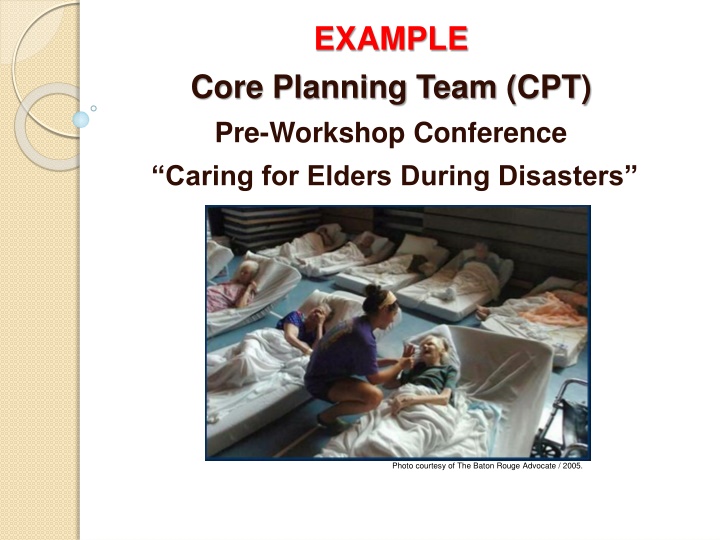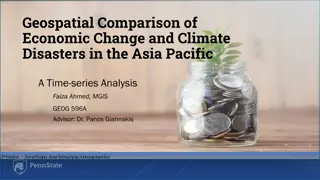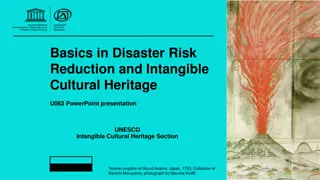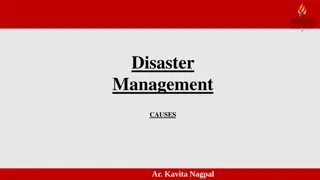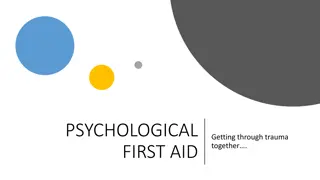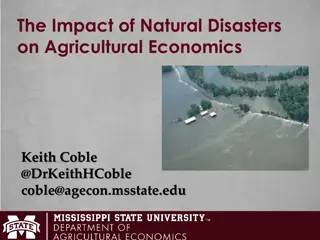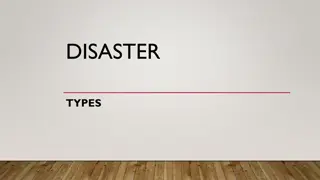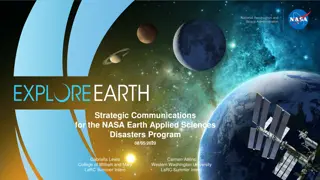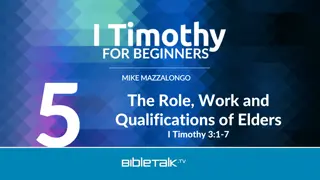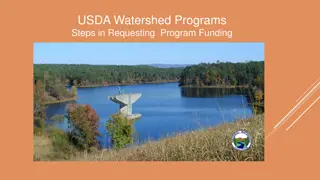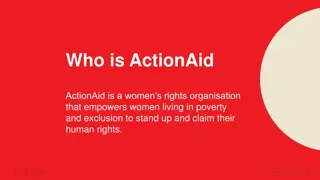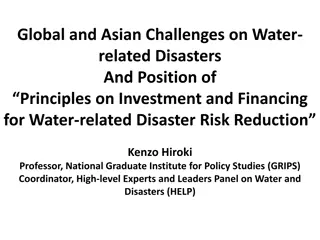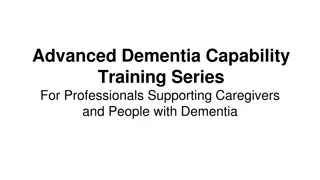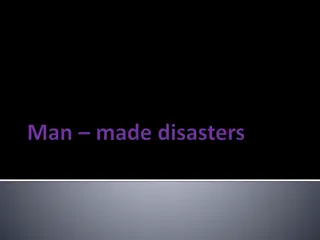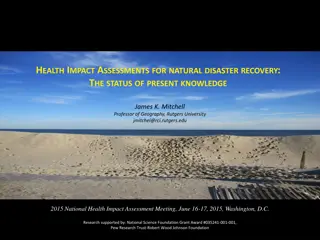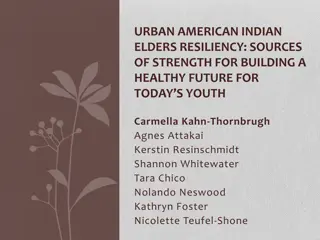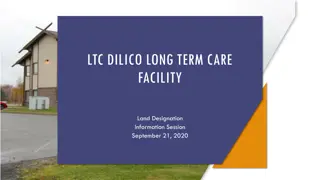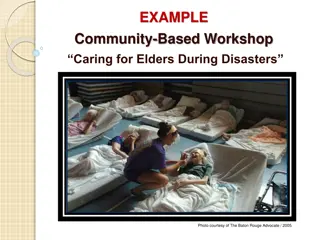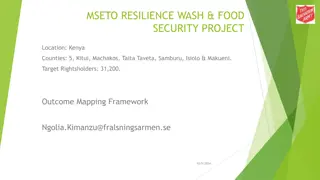Project Overview: Empowering Communities to Care for Elders During Disasters
Healthcare professionals and stakeholders in Florida collaborate on a project to identify and address the complex needs of the elderly during emergencies. Through workshops and analysis, a comprehensive methodology is developed to ensure the well-being of seniors amidst disasters.
Download Presentation

Please find below an Image/Link to download the presentation.
The content on the website is provided AS IS for your information and personal use only. It may not be sold, licensed, or shared on other websites without obtaining consent from the author.If you encounter any issues during the download, it is possible that the publisher has removed the file from their server.
You are allowed to download the files provided on this website for personal or commercial use, subject to the condition that they are used lawfully. All files are the property of their respective owners.
The content on the website is provided AS IS for your information and personal use only. It may not be sold, licensed, or shared on other websites without obtaining consent from the author.
E N D
Presentation Transcript
EXAMPLE Core Planning Team (CPT) Pre-Workshop Conference Caring for Elders During Disasters Photo courtesy of The Baton Rouge Advocate / 2005.
Welcome & Introductions Planning Partners & Hosts Debbie Peck, Emergency Management Coordinator Pinellas County Office of Emergency Management Jason Martino, Emergency Coordinating Officer Area Agency on Aging of Pinellas & Pasco Amber Boulding, Public Health Preparedness Manager Florida Department of Health - Pinellas County Project Team Ray Runo, Project Director Disasters, Strategies, & Ideas Group (DSI) Robin Bleier, President RB Health Partners April Henkel, Project Manager Florida Health Care Association CPT Partners 2
Meeting Purpose Provide an overview of the project Define the purpose & role of the Core Planning Team Review the Community-Based Planning Process and the continuum framework Establish a list of workshop invitees Review the workshop agenda & identify local SMEs to support the workshop s goals Confirm the workshop date and venue Establish a CPT post-workshop meeting schedule 3
Project Overview Healthcare Systems Needs Analysis for Elders During Disasters A project funded by the Fla. Dept. of Health 4
Project Origin and Purpose Our History and Experience Project Rationale & Need for the Project Vision During disasters, the complex health and medical needs of Florida s elder population will be met. Mission To develop and implement a comprehensive methodology for identifying and codifying disaster roles and responsibilities for the many stakeholders comprising the continuum of healthcare for Florida s elder population during disasters. 5
Three Year Project Identification of Elder Care Stakeholders Established a Core Planning Team Conducted regional stakeholder workshops Analyzed stakeholder roles & responsibilities Developed Continuum of Healthcare for Elders During Disasters & Planning Considerations (and tested the model) Preparing Communities to Care for Elders During Disasters the Community-Based Process 6
The Core Planning Team (CPT) 7
The Role the Core Planning Team Provides guidance and direction for the community-based planning process Identifies the key stakeholders involved in the local community s healthcare and support continuum for elders Supports the community s response to gaps identified through community-based planning Actively facilitates integration of elder healthcare and support stakeholders into a local community s emergency management, preparedness, response and recovery system
Elder Care Continuum Stakeholders County Emergency Management (EM) & Health Department (ESF8) Area Agency on Aging (AAA) 2-1-1 agencies (information and referral network) Alzheimer s caregiver support organizations Behavioral Health Providers COAD / VOAD (when active in a community), including Red Cross Councils on Aging / Senior Centers / Other aging network provider organizations Emergency Response Agencies (e.g., EMS, fire, law enforcement) Energy providers Home health agencies & geriatric care managers Hospitals & other healthcare providers (e.g., clinics, medical equipment, VA) HUD housing (for seniors) Nursing homes, assisted living facilities & continuing care retirement communities Pharmacies Renal dialysis centers Selected Govt. partners (Dept. of Elder Affairs; Co. Health Dept.; Agency for Health Care Admin.; Adult Protective Serv./Dept. of Children & Families; Veterans Affairs) Transportation providers OTHER groups important in the healthcare continuum for elders in the local community 9
The Community-Based Planning Process & Continuum Framework 10
The Community-Based Planning Process Identifies, engages and integrates all key stakeholders involved in elder care during disasters Results in specific solutions to improve the community s capability to care for elders during disasters 11
Why is this approach needed? Emergency planners often lack awareness of the vulnerability and complex care requirements of many elders The scope of healthcare stakeholders for elders is broad and complex with many dependent and interdependent roles and responsibilities to coordinate and integrate Communities (& stakeholders) have varied levels of preparedness, planning & response capabilities/capacities Elder care stakeholders may not be actively integrated into the community s emergency management planning 12
Expected Outcomes Gain knowledge and understanding of current community resources, capabilities & plans for care of elders, across the healthcare and support continuum Identify the desired state of preparedness, response, & mitigation capabilities for elder care Identify gaps between the current capabilities & the desired state Develop action plans, timelines & responsibilities for filling gaps Develop sustainment strategies for on-going planning & partnerships 13
Planning & Workshop Sequence Concept & Objectives Meeting (EM, ESF8, AAA) First meeting of the Lead Team (EM, ESF8, AAA); typically 75 minutes Goal: Brief the lead team; develop tentative timeline; identify CPT members CPT Pre-Workshop Conference Typically a 2 to 3 hour planning meeting of the CPT Goal: Invitation list, workshop date, speakers and agenda Community-Based Workshop All stakeholders/partners identified by the CPT Structured agenda and process Goal: Identify gaps in the continuum of healthcare for elders during disasters, in your community & solutions Post-Workshop Planning Session(s) De-briefing ~~ action plans ~~next-steps Additional meetings as needed Incorporate Action Plans Sustaining the Process into EM s preparedness & response system into the plans of key partners (e.g., AAAs) 14
The Framework: Healthcare & Support Continuum for Elders during Disasters 15
Planning for the care of elders during disasters begins with an understanding of the community s Healthcare and Support Continuum for Elders 16
Continuum of Care - Assumptions Individuals are unique - common care & support services. Condition and needs will change over the term of the disaster (decompensation). In a disaster environment, healthcare, services and support will be limited, temporarily unavailable, or absent. Expect negative outcomes when the continuum is disrupted or broken. Community Resiliency: Augmentation or Replacement Strategies 17
Elder-Focused Planning Considerations Elders require a comprehensive approach to disaster-based planning considerations: #1 Elder community profile what are the characteristics of your elder population and who are the stakeholders that serve them? #2 Risk identification and management how vulnerable are your elders? #3 Continuum of healthcare and support systems for elders who are your stakeholders and what are their roles? #4 Community preparedness & response planning for elder populations how integrated and comprehensive are your stakeholders emergency plans (your continuum s stakeholders)? 18
Planning Consideration #1 Characterizing the Elder Population Elder demographics and locations Residential Areas/Mapping Service Providers (stakeholder groups) Elders living independently Elder Population Vulnerabilities Morbidity and mortality issues Behavior during disasters Decompensation 19
Planning Consideration #2 Risk Identification and Management Community hazards and vulnerabilities Specific hazard impacts on elders Clinical risk factors Strategies for managing elder risk factors Elder healthcare system demands versus community capabilities Community resilience considerations 20
Planning Consideration #3 Continuum of Healthcare Systems for Elders During Disasters Population demographics (demand) and local stakeholder capabilities (supply) drive the continuum Identify healthcare, community, and social support systems present on a sunny day Building your continuum Visual and descriptive tools 21
On a Sunny Day in a Typical Community: Proportional Use of Healthcare Systems & Supports by Elders 22
On a Rainy Day in a Typical Community: ACUTE CARE Hospital settings Skilled Nursing Care Utilization limited by regulatory caps Shifts in Proportional Use of Healthcare Systems & Supports by Elders Assisted Living Elder Lives in a Care Community Utilization limited by regulatory caps Extensive Support: Elder Living in the Community Increased # of elders w/ complex health issues & limited ADL capability requires extensive support from healthcare system providers Moderate Support: Elder Living Independently in the Community Increased # of elders needing more support than informal networks can provide SPECIAL NEEDS SHELTERS Some Support: Elder Living Independently in the Community Previously independent elders now need support & help GENERAL SHELTERS SPECIAL NEEDS SHELTERS Elder Living Independently in the Community A smaller number are able to sustain independence GENERAL SHELTERS 23
The Continuum Framework Similar to the continuum of care concept in aging services there are many stakeholders in the continuum of healthcare & support services Reflects functional roles and responsibilities, relationships, dependencies, and interdependencies that link stakeholders together on behalf of elders during disasters Supports the identification of gaps in the healthcare continuum for elders during disasters 24
Continuum of Healthcare & Support for Elders ~~ A Complex System ~~ Social Networks Hobbies & Interests Faith Based Support Medical Equip. & Supplies Home Health Care Community Support Services (e.g., Food Bank) Transportation Electricity Water Personal Residence Air / Oxygen Senior Centers & Activities Vulnerable Elders Food Family support Personal Disaster Plan Healthcare Facility Heathcare (Medical Services) Medicine Home- & Community Based Services Caregiver Support Community Disaster Plan Assisted Living Retirement Communities Federal Disaster Resources Shelter Resources State Disaster Resources 25
Continuum of Healthcare ~~ Normal (Sunny) Day ~~ Family Support Home & Comm.- based Services Medical Equipment & Supplies Medical Support Services Medications An Individual Elder s Healthcare & Support Continuum Transp. Services Utilities Green = OK Yellow = Reduced Red = Off-line Faith Based Support Food and Water Social Supports (e.g. friends; neighbors) 26
Continuum of Healthcare ~~ Disaster (Rainy Day) ~~ Time Progression Decompensation Family Support Home- & Comm.- based Services Utilities Medical Support Services Faith Based Support Elder Medical Equip. & Supplies Transp. Services Green = OK Yellow = Reduced Red = Off-line Social Support Services Food & Water Medications 27
Continuum of Healthcare ~~ Disaster (Rainy Day) ~~ Shelter? Hospital? Home & Comm.- based Serv. Time Progression Continuum disrupted Advanced decompensation What next? Family/friends? Shelter? Hospital? What are the community s planning contingencies? Family Support Medical Support Services Utilities Elder Faith Based Support Transp. Services Food & Water Medical Equip. & Supplies Green = OK Yellow = Reduced Red = Off-line Social Support Services Medica- tions 28
A Stakeholder Example Admin (payroll) Other Contract Services / Vendors Volun- teers Transp. Providers Physical Plant / Maint. Area Agency on Aging Continuum Electricity - Utilities Nutrition Providers CCE Providers Phones Green = OK Yellow = Reduced Red = Off-line Info. Tech. (IT) Senior Centers Off-Site Facilities (other AAA offices) Info. & Referral Services
Another Stakeholder Example Admin. (e.g. payroll) Other Contract Services / Vendors Funding (e.g. govt., UW) Green = OK Yellow = Reduced Red = Off-line Volun- teer Services Transp. Services Phys. Plant & Maint. Senior Center Activity Staff Health / Serv. Staff Utilities Case Mgrs. Phones Info. Tech. (IT) Care- giver Supports Off-Site Facilities (e.g. meal sites)
Hurricane Impacts: Essential Systems Reduced or Off-Line Admin (e.g. payroll) Transp. Providers Volun- teers Physical Plant / Maint. Nutrition Providers Area Agency on Aging CCE Providers Electricity - Utilities Senior Centers Phones Green = OK Yellow = Reduced Red = Off-line Info. Tech. (IT) Info. & Referral Services Off-Site Facilities (other AAA offices)
Another Stakeholder Example Admin. (e.g. payroll) Other Contract Services / Vendors Funding (e.g. govt., UW) Green = OK Yellow = Reduced Red = Off-line Volun- teer Services Transp. Services Phys. Plant & Maint. Senior Center Activity Staff Health / Serv. Staff Utilities Phones Case Mgrs. Info. Tech. (IT) Care- giver Supports Off-Site Facilities (e.g. meal sites)
Planning Consideration #4 Community Preparedness & Response Planning for Elder Populations Planning requirements legislative & others Planning guidance tools and resources Response triggers and contingency plans Identification, involvement, and integration of community partners What service and support systems exist? Integration into local EM and ESF 8 planning, training, and exercise programs 33
Applying the Planning Considerations: The Community-Based Workshop 34
Pinellas County Community-Based Workshop Caring for Elders During Disasters Tuesday, April 8, 2014 ~~ 8:30am 4:30pm Mid-County Health Department Conference Center 8751 Ulmerton Road, Largo 35
Workshop Agenda Start Time: 8:30 a.m. End Time: 4:30 p.m. 36
Agenda Morning Topics Part 1: Overview Welcome, Workshop Briefing and Stakeholder Introductions Project Purpose & Rationale Planning Considerations for Care of Elders during Disasters o Community-Based Planning Outcomes o Part 2: Framework for Community-Based Planning - The Continuum Model This is an interactive discussion. Use flipcharts to capture comments. Utilize SMEs identified by the CPT as resources for information (e.g., EM, ESF8 & AAA). Community Profile: Characterizing the Elder Population (People and Stakeholder Roles & Responsibilities) SMEs: ________________ Disaster Risks and Vulnerabilities for Elder Population SMEs: ________________ Continuum of Healthcare and Support Systems for Elders SMEs: ________________ Community Preparedness and Response Planning for Elder Populations SMEs: ________________ Part 3: Using the Continuum of Healthcare and Support Systems Work through the sunny day perspective: each person develops petals for their respective organization, followed by the full group identifying petals for the community. Record highlights on flipcharts. Discuss & Diagram -- Individual Stakeholder Continuum (individual work 15 min.) Discuss and Diagram - Local Community Continuum (plot on the vector diagram) 37
Agenda Afternoon Topics Part 4: Scenario-Based Group Discussion (Pre-Impact) Facilitated discussion; capture highlights on flipcharts. Scenario Pre-Impact Conditions utilize continuum diagrams & overview of planning considerations to discuss current state, desired state & gaps Part 5: Scenario-Based Group Discussion (Post-Impact) Facilitated discussion; capture highlights on flipcharts. Scenario Post-Impact Conditions - utilize continuum diagrams and overview of planning considerations to discuss: Current State, Desired State, and Gaps Part 6: Comments/Questions/Evaluation Review and discuss gaps identified Discuss strategies for filling gaps (prospective partners and methods) Evaluation & Final Comments Workshop Ends: 4:30 pm 38
Workshop Outcomes & Next Steps Workshop Outcomes: Knowledge of current community resources, capabilities & plans for care of elders, across the healthcare and support continuum Description of the desired state of preparedness, response, & mitigation capabilities for elders Identification of gaps between the current capabilities & desired state CPT s Next Steps: Action plans, timelines & responsibilities for filling gaps. Sustainment strategies for on-going planning & partnerships 39
After the Community-Based Workshop Reconvene the CPT Present/discuss key findings from the Workshop (gaps, etc.) Develop an Integrated After Action Process and Action Plans (across stakeholder groups) Sustain the Process: Plan ~~ Train ~~ Exercise ~~ Evaluate 40
Todays Decisions: Decide who will be invited to the workshop (stakeholders) Select subject matter experts Post-workshop CPT meeting (?) 41
Who should attend? Maximum # of attendees - 40 Invitees: CPT Members (you!) Other stakeholders (Who else? ) (See next slide for ideas ) 42
Pinellas County Stakeholders --Seniors? --Primary Care? --V.A.? --Who else? Social Networks Hobbies & Interests Faith Based Support Medical Equip. & Supplies Home Health Care Community Support Services (e.g., Food Bank) Transportation Electricity Water Personal Residence Air / Oxygen Senior Centers & Activities Vulnerable Elders Food Family support Personal Disaster Plan Healthcare Facility Heathcare (Medical Services) Medicine Home- & Community Based Services Caregiver Support Community Disaster Plan Assisted Living Retirement Communities Federal Disaster Resources Shelter Resources State Disaster Resources 43
Elder Care Continuum Stakeholders County Emergency Management (EM) & Health Department (ESF8) Area Agency on Aging (AAA) 2-1-1 agencies (information and referral network) Alzheimer s caregiver support organizations Behavioral Health Providers COAD / VOAD (when active in a community), including Red Cross Councils on Aging / Senior Centers / Other aging network provider organizations Emergency Response Agencies (e.g., EMS, fire, law enforcement) Energy providers Home health agencies & geriatric care managers Hospitals & other healthcare providers (e.g., clinics, medical equipment, VA) HUD housing (for seniors) Nursing homes, assisted living facilities & continuing care retirement communities Pharmacies Renal dialysis centers Selected Govt. partners (Dept. of Elder Affairs; Co. Health Dept.; Agency for Health Care Admin.; Adult Protective Serv./Dept. of Children & Families; Veterans Affairs) Transportation providers OTHER groups important in the healthcare continuum for elders in the local community 44
Subject Matter Experts (local) Elder population profile: ______________________ Related risks & vulnerabilities: _________________ Pinellas County s continuum: __________________ Preparedness & response planning: ____________ 45
Post-workshop CPT Meeting? Meet morning of April 9? Meet at a later date via phone? Other Options? 46
~ For More Information ~ Ray Runo (rayruno@gmail.com) April Henkel (ahenkel@fhca.org) Robin Bleier (robin@rbhealthpartners.com) 48
